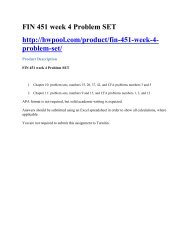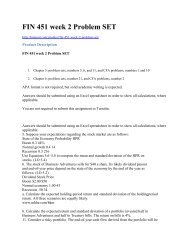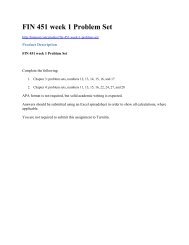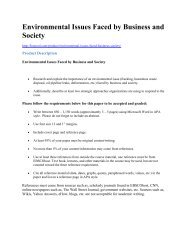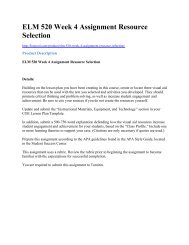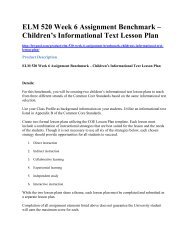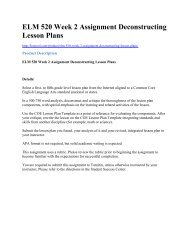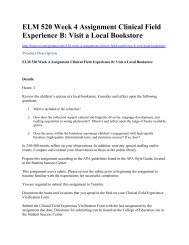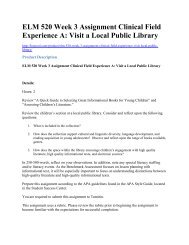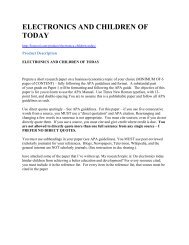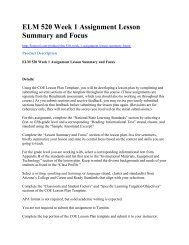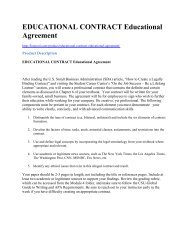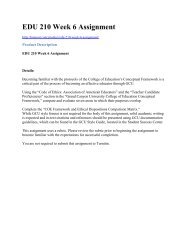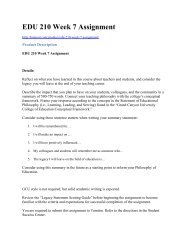FIN 451 All Weeks Problem Set
You also want an ePaper? Increase the reach of your titles
YUMPU automatically turns print PDFs into web optimized ePapers that Google loves.
<strong>FIN</strong> <strong>451</strong> <strong>All</strong> <strong>Weeks</strong> <strong>Problem</strong> <strong>Set</strong><br />
http://hwpool.com/product/fin-<strong>451</strong>-weeks-problem-set/<br />
Product Description<br />
<strong>FIN</strong> <strong>451</strong> <strong>All</strong> <strong>Weeks</strong> <strong>Problem</strong> <strong>Set</strong><br />
<strong>FIN</strong><strong>451</strong> week 1 <strong>Problem</strong> <strong>Set</strong><br />
Complete the following:<br />
1. Chapter 3: problem sets, numbers 12, 13, 14, 15, 16, and 17<br />
2. Chapter 4: problem sets, numbers 11, 13, 15, 16, 22, 24, 27, and 28<br />
APA format is not required, but solid academic writing is expected.<br />
Answers should be submitted using an Excel spreadsheet in order to show all calculations, where<br />
applicable.<br />
You are not required to submit this assignment to Turnitin.<br />
<strong>FIN</strong><strong>451</strong> week 2 <strong>Problem</strong> SET<br />
1. Chapter 5: problem sets, numbers 5, 6, and 11, and CFA problems, numbers 1 and 10<br />
2. Chapter 6: problem sets, number 21, and CFA problems, number 2<br />
APA format is not required, but solid academic writing is expected.<br />
Answers should be submitted using an Excel spreadsheet in order to show all calculations, where<br />
applicable.<br />
You are not required to submit this assignment to Turnitin.
Answers should be submitted using an Excel spreadsheet in order to show all calculations, where<br />
applicable.<br />
5. Suppose your expectations regarding the stock market are as follows:<br />
State of the Economy Probability HPR<br />
Boom 0.3 44%<br />
Normal growth 0.4 14<br />
Recession 0.3 216<br />
Use Equations 5.6–5.8 to compute the mean and standard deviation of the HPR on<br />
stocks. (LO 5-4)<br />
6. The stock of Business Adventures sells for $40 a share. Its likely dividend payout<br />
and end-of-year price depend on the state of the economy by the end of the year as<br />
follows: (LO 5-2)<br />
Dividend Stock Price<br />
Boom $2.00 $50<br />
Normal economy 1.00 43<br />
Recession .50 34<br />
a. Calculate the expected holding-period return and standard deviation of the holdingperiod<br />
return. <strong>All</strong> three scenarios are equally likely.<br />
www.mhhe.com/bkm<br />
b. Calculate the expected return and standard deviation of a portfolio invested half in<br />
Business Adventures and half in Treasury bills. The return on bills is 4%.<br />
11. Consider a risky portfolio. The end-of-year cash flow derived from the portfolio will be<br />
either $50,000 or $150,000, with equal probabilities of .5. The alternative riskless<br />
investment in T-bills pays 5%. (LO 5-3)<br />
a. If you require a risk premium of 10%, how much will you be willing to pay for the<br />
portfolio?<br />
b. Suppose the portfolio can be purchased for the amount you found in ( a ). What will<br />
the expected rate of return on the portfolio be?<br />
c. Now suppose you require a risk premium of 15%. What is the price you will be willing<br />
to pay now?<br />
d. Comparing your answers to ( a ) and ( c ), what do you conclude about the relationship<br />
between the required risk premium on a portfolio and the price at which the portfolio<br />
will sell?<br />
1. A portfolio of nondividend-paying stocks earned a geometric mean return of 5%<br />
between January 1, 2005, and December 31, 2011. The arithmetic mean return for<br />
the same period was 6%. If the market value of the portfolio at the beginning of<br />
2005 was $100,000, what was the market value of the portfolio at the end of<br />
2011?<br />
10. Probabilities for three states of the economy and probabilities for the returns on a<br />
particular stock in each state are shown in the table below.<br />
State of Economy<br />
Probability of<br />
Economic State
Stock<br />
Performance<br />
Probability of Stock<br />
Performance in Given<br />
Economic State<br />
Good .3 Good .6<br />
Neutral .3<br />
Poor .1<br />
Neutral .5 Good .4<br />
Neutral .3<br />
Poor .3<br />
Poor .2 Good .2<br />
Neutral .3<br />
Poor .5<br />
What is the probability that the economy will be neutral and the stock will experience<br />
poor performance?<br />
Chapter 6<br />
21. The following figure shows plots of monthly rates of return and the stock market for<br />
two stocks. (LO 6-5)<br />
a. Which stock is riskier to an investor currently holding her portfolio in a diversified<br />
portfolio of common stock?<br />
b. Which stock is riskier to an undiversified investor who puts all of his funds in only<br />
one of these stocks?<br />
2. George Stephenson’s current portfolio of $2 million is invested as follows:<br />
Summary of Stephenson’s Current Portfolio<br />
Value<br />
Percent of<br />
Total<br />
Expected<br />
Annual<br />
Return<br />
Annual<br />
Standard<br />
Deviation<br />
Short-term bonds $ 200,000 10% 4.6% 1.6%<br />
Domestic large-cap equities 600,000 30 12.4 19.5<br />
Domestic small-cap equities 1,200,000 60 16.0 29.9<br />
Total portfolio $2,000,000 100% 13.8% 23.1%<br />
Stephenson soon expects to receive an additional $2 million and plans to invest the entire<br />
amount in an index fund that best complements the current portfolio. Stephanie Coppa,<br />
CFA, is evaluating the four index funds shown in the following table for their ability to<br />
produce a portfolio that will meet two criteria relative to the current portfolio: (1) maintain<br />
or enhance expected return and (2) maintain or reduce volatility<br />
Each fund is invested in an asset class that is not substantially represented in the<br />
current portfolio.<br />
Index Fund Characteristics
Index Fund<br />
Expected Annual<br />
Return<br />
Expected Annual<br />
Standard Deviation<br />
Correlation of Returns<br />
with Current Portfolio<br />
Fund A 15% 25% 10.80<br />
Fund B 11 22 10.60<br />
Fund C 16 25 10.90<br />
Fund D 14 22 10.65<br />
State which fund Coppa should recommend to Stephenson. Justify your choice by<br />
describing how your chosen fund best meets both of Stephenson’s criteria. No calculations<br />
are required.<br />
<strong>FIN</strong><strong>451</strong> week 3 <strong>Problem</strong> SET<br />
1. Chapter 7: problem sets, numbers 8a, 8b, 24, and 28, and CFA problems, number 2>APA format<br />
is not required, but solid academic writing is expected.<br />
2. Answers should be submitted using an Excel spreadsheet in order to show all calculations, where<br />
applicable.<br />
Chapter 8: problem sets, number 18, and CFA problems, numbers 7, 8, and 10<br />
1. APA format is not required, but solid academic writing is expected.<br />
2. A title page is expected.<br />
Answers should be submitted using a Word document.<br />
You are not required to submit this assignment to Turnitin.<br />
APA format is not required, but solid academic writing is expected.<br />
Answers should be submitted using an Excel spreadsheet in order to show all calculations, where<br />
applicable.
15. Treasury bonds paying an 8% coupon rate with semiannual payments currently sell at par<br />
value. What coupon rate would they have to pay in order to sell at par if they paid their<br />
coupons annually?<br />
20. Fill in the table below for the following zero-coupon bonds, all of which have par values<br />
of $1,000. (LO 10-2)<br />
Price Maturity (years) Yield to Maturity<br />
$400 20 ?<br />
$500 20 ?<br />
$500 10 ?<br />
? 10 10%<br />
? 10 8%<br />
$400 ? 8%<br />
37. The yield curve is upward-sloping. Can you conclude that investors expect short-term<br />
interest rates to rise? Why or why not?<br />
42. The following table contains spot rates and forward rates for three years. However, the<br />
labels got mixed up. Can you identify which row of the interest rates represents spot<br />
rates and which one the forward rates?<br />
3. A convertible bond has the following features:<br />
Coupon 5.25%<br />
Maturity June 15, 2020<br />
Market price of bond $77.50<br />
Market price of underlying common stock $28.00<br />
Annual dividend $1.20<br />
Conversion ratio 20.83 shares<br />
Calculate the conversion premium for this bond.<br />
5. Bonds of Zello Corporation with a par value of $1,000 sell for $960, mature in five years,<br />
and have a 7% annual coupon rate paid semiannually. (LO 10-6)<br />
a. Calculate the:<br />
(1) Current yield.<br />
(2) Yield to maturity.<br />
(3) Horizon yield (also called realized compound return) for an investor with a threeyear<br />
holding period and a reinvestment rate of 6% over the period. At the end of<br />
three years the 7% coupon bonds with two years remaining will sell to yield 7%.<br />
b. Cite one major shortcoming for each of the following fixed-income yield measures:<br />
(1) Current yield.<br />
(2) Yield to maturity.<br />
(3) Horizon yield (also called realized compound return).<br />
CHAPTER 11<br />
9. A nine-year bond has a yield of 10% and a duration of 7.194 years. If the bond’s yield<br />
changes by 50 basis points, what is the percentage change in the bond’s price?<br />
15. You will be paying $10,000 a year in tuition expenses at the end of the next two years.<br />
Bonds currently yield 8%. (LO 11-2)<br />
a. What is the present value and duration of your obligation?<br />
b. What maturity zero-coupon bond would immunize your obligation?<br />
c. Suppose you buy a zero-coupon bond with value and duration equal to your obligation.<br />
Now suppose that rates immediately increase to 9%. What happens to your net
position, that is, to the difference between the value of the bond and that of your<br />
tuition obligation? What if rates fall to 7%?<br />
1. Rank the following bonds in order of descending duration. (LO 11-2)<br />
Bond Coupon Time to Maturity Yield to Maturity<br />
A 15% 20 years 10%<br />
B 15 15 10<br />
C 0 20 10<br />
D 8 20 10<br />
E 15 15 15<br />
3. As part of your analysis of debt issued by Monticello Corporation, you are asked to evaluate<br />
two specific bond issues, shown in the table below.MONTICELLO CORPORATION BOND<br />
INFORMATION<br />
Bond A (callable) Bond B (noncallable)<br />
Maturity 2019 2019<br />
Coupon 11.50% 7.25%<br />
Current price 125.75 100.00<br />
Yield to maturity 7.70% 7.25%<br />
Modified duration to maturity 6.20 6.80<br />
Call date 2013 —<br />
Call price 105 —<br />
Yield to call 5.10% —<br />
Modified duration to call 3.10 —<br />
a. Using the duration and yield information in the table, compare the price and yield<br />
behavior of the two bonds under each of the following two scenarios:<br />
i. Strong economic recovery with rising inflation expectations.<br />
ii. Economic recession with reduced inflation expectations.<br />
b. Using the information in the table, calculate the projected price change for bond B if<br />
the yield-to-maturity for this bond falls by 75 basis points.<br />
c. Describe the shortcoming of analyzing bond A strictly to call or to maturity.<br />
12. The following bond swaps could have been made in recent years as investors attempted<br />
to increase the total return on their portfolio.From the information presented below, identify<br />
possible reason(s) that investors<br />
may have made each swap. (LO 11-5)<br />
Action Call Price YTM (%)<br />
a. Sell Baa1 Electric Pwr. 1st mtg. 63 8% due 2017 108.24 95 7.71<br />
Buy Baa1 Electric Pwr. 1st mtg. 23 8% due 2018 105.20 79 7.39<br />
b. Sell Aaa Phone Co. notes 51 2% due 2018 101.50 90 7.02<br />
Buy U.S. Treasury notes 61 2% due 2018 NC 97.15 6.78<br />
c. Sell Aa1 Apex Bank zero coupon due 2020 NC 45 7.51<br />
Buy Aa1 Apex Bank float rate notes due 2033 103.90 90 —<br />
d. Sell A1 Commonwealth Oil & Gas 1st mtg. 6% due 2023 105.75 72 8.09<br />
Buy U.S. Treasury bond 51 2% due 2029 NC 80.60 7.40<br />
e. Sell A1 Z mart convertible deb. 3% due 2023 103.90 62 6.92<br />
Buy A2 Lucky Ducks deb. 73 4% due 2029 109.86 75 10.43
<strong>FIN</strong><strong>451</strong> week 4 <strong>Problem</strong> SET<br />
1. Chapter 10: problem sets, numbers 15, 20, 37, 42, and CFA problems numbers 3 and 5<br />
2. Chapter 11: problem sets, numbers 9 and 15, and CFA problems numbers 1, 3, and 12<br />
APA format is not required, but solid academic writing is expected.<br />
Answers should be submitted using an Excel spreadsheet in order to show all calculations, where<br />
applicable.<br />
You are not required to submit this assignment to Turnitin.<br />
<strong>FIN</strong><strong>451</strong> week 5 <strong>Problem</strong> SET<br />
1. Chapter 9: problem sets, numbers 11, 12, 18 and 20, and CFA problems, numbers 3 and 5<br />
2. Chapter 13: problem sets, numbers 10, 11, 16, 17, 19, and 20, and CFA problems, numbers 4 and<br />
6<br />
APA format is not required, but solid academic writing is expected.<br />
Answers should be submitted using an Excel spreadsheet in order to show all calculations, where<br />
applicable.<br />
You are not required to submit this assignment to Turnitin.<br />
<strong>FIN</strong><strong>451</strong> week 6 <strong>Problem</strong> SET
1. Chapter 15: problem sets, numbers 10, 13, and 24, and CFA problems, number 4<br />
2. Chapter 16: problem sets, numbers 10, 11, 12, and 28<br />
APA format is not required, but solid academic writing is expected.<br />
Answers should be submitted using an Excel spreadsheet in order to show all calculations, where<br />
applicable.<br />
You are not required to submit this assignment to Turnitin.<br />
Answers should be submitted using an Excel spreadsheet in order to show all calculations, where<br />
applicable.<br />
CHAPTER 15<br />
10. An investor purchases a stock for $38 and a put for $.50 with a strike price of $35. The<br />
investor sells a call for $.50 with a strike price of $40. What is the maximum profit and<br />
loss for this position? Draw the profit and loss diagram for this strategy as a function of<br />
the stock price at expiration.<br />
13. The common stock of the P.U.T.T. Corporation has been trading in a narrow price range<br />
for the past month, and you are convinced it is going to break far out of that range in the<br />
next three months. You do not know whether it will go up or down, however. The current<br />
price of the stock is $100 per share, the price of a three-month call option with an<br />
exercise price of $100 is $10, and a put with the same expiration date and exercise price<br />
costs $7. (L O 15-2)<br />
a. What would be a simple options strategy to exploit your conviction about the stock<br />
price’s future movements?<br />
b. How far would the price have to move in either direction for you to make a profit on<br />
your initial investment?<br />
24. A put option with strike price $60 trading on the Acme options exchange sells for $2. To<br />
your amazement, a put on the firm with the same expiration selling on the Apex options<br />
exchange but with strike price $62 also sells for $2. If you plan to hold the options position<br />
until expiration, devise a zero-net-investment arbitrage strategy to exploit the pricing<br />
anomaly. Draw the profit diagram at expiration for your position.<br />
4. Suresh Singh, CFA, is analyzing a convertible bond. The characteristics of the bond and<br />
the underlying common stock are given in the following exhibit:<br />
Convertible Bond Characteristics<br />
Par value $1,000<br />
Annual coupon rate (annual pay) 6.5%<br />
Conversion ratio 22<br />
Market price 105% of par value<br />
Straight value 99% of par value<br />
Underlying Stock Characteristics<br />
Current market price $40 per share
Annual cash dividend $1.20 per share<br />
Compute the bond’s: (LO 15-3)<br />
a. Conversion value.<br />
b. Market conversion price.<br />
CHAPTER 16<br />
10. Which of the following best explains a delta-neutral portfolio? A delta-neutral portfolio<br />
is perfectly hedged against: (LO 16-5)<br />
a. Small price changes in the underlying asset.<br />
b. Small price decreases in the underlying asset.<br />
c. <strong>All</strong> price changes in the underlying asset.<br />
11. After discussing the concept of a delta-neutral portfolio, Washington determines that he<br />
needs to further explain the concept of delta. Washington draws the value of an option<br />
as a function of the underlying stock price. Draw such a diagram, and indicate how delta<br />
is interpreted. Delta is the: (LO 16-5)<br />
a. Slope in the option price diagram.<br />
b. Curvature of the option price graph.<br />
c. Level in the option price diagram.<br />
12. Washington considers a put option that has a delta of 2 .65. If the price of the underlying<br />
asset decreases by $6, then what is the best estimate of the change in option<br />
price?<br />
28. According to the Black-Scholes formula, what will be the value of the hedge ratio of a<br />
put option for a very small exercise price? (<br />
<strong>FIN</strong><strong>451</strong> week 7 <strong>Problem</strong> SET<br />
1. Chapter 18: problem sets, number 7, and CFA problems, numbers 2, 3, 4, and 6<br />
2. Chapter 19: problem sets, numbers 5 and 8, and CFA problems, numbers 2 and 3<br />
APA format is not required, but solid academic writing is expected.<br />
Answers should be submitted using an Excel spreadsheet in order to show all calculations, where<br />
applicable.<br />
You are not required to submit this assignment to Turnitin.<br />
APA format is not required, but solid academic writing is expected.
Answers should be submitted using an Excel spreadsheet in order to show all calculations, where<br />
applicable.<br />
CHAPTER 18<br />
7. Consider the following information regarding the performance of a money manager in a<br />
recent month. The table presents the actual return of each sector of the manager’s portfolio<br />
in column (1), the fraction of the portfolio allocated to each sector in column (2), the<br />
benchmark or neutral sector allocations in column (3), and the returns of sector indexes in<br />
column (4).<br />
2. The chairman provides you with the following data, covering one year, concerning the<br />
portfolios of two of the fund’s equity managers (manager A and manager B). Although<br />
the portfolios consist primarily of common stocks, cash reserves are included in the calculation<br />
of both portfolio betas and performance. By way of perspective, selected data for<br />
the financial markets are included in the following table. (LO 18-1)<br />
Total Return Beta<br />
Manager A 24.0% 1.0<br />
Manager B 30.0 1.5<br />
S&P 500 21.0<br />
Lehman Bond Index 31.0<br />
91-day Treasury bills 12.0<br />
a. Calculate and compare the alpha of the two managers relative to each other and to the<br />
S&P 500.<br />
b. Explain two reasons the conclusions drawn from this calculation may be misleading.<br />
3. Carl Karl, a portfolio manager for the Alpine Trust Company, has been responsible since<br />
2015 for the City of Alpine’s Employee Retirement Plan, a municipal pension fund.<br />
Alpine is a growing community, and city services and employee payrolls have expanded in<br />
each of the past 10 years. Contributions to the plan in fiscal 2020 exceeded benefit payments<br />
by a three-to-one ratio.<br />
Th e plan’s board of trustees directed Karl fi ve years ago to invest for total return over the<br />
long term. However, as trustees of this highly visible public fund, they cautioned him that<br />
volatile or erratic results could cause them embarrassment. Th ey also noted a state statute that<br />
mandated that not more than 25% of the plan’s assets (at cost) be invested in common stocks.<br />
At the annual meeting of the trustees in November 2020, Karl presented the following<br />
portfolio and performance report to the board.ALPINE EMPLOYEE RETIREMENT PLAN<br />
Asset Mix as of 9/30/20<br />
At Cost<br />
(millions)<br />
At Market<br />
(millions)<br />
Fixed-income assets:<br />
Short-term securities $ 4.5 11.0% $ 4.5 11.4%<br />
Long-term bonds and mortgages 26.5 64.7 23.5 59.5<br />
Common stocks 10.0 24.3 11.5 29.1<br />
$41.0 100.0% $39.5 100.0%<br />
INVESTMENT PERFORMANCE<br />
Annual Rates of<br />
Return for Periods
Ending 9/30/20<br />
5 Years 1 Year<br />
Total Alpine Fund:<br />
Time-weighted 8.2% 5.2%<br />
Dollar-weighted (Internal) 7.7% 4.8%<br />
Assumed actuarial return 6.0% 6.0%<br />
U.S. Treasury bills 7.5% 11.3%<br />
Large sample of pension funds<br />
(average 60% equities, 40% fixed income) 10.1% 14.3%<br />
Common stocks—Alpine Fund 13.3% 14.3%<br />
Average portfolio beta coefficient 0.90 0.89<br />
Standard & Poor’s 500 Stock Index 13.8% 21.1%<br />
Fixed-income securities—Alpine Fund 6.7% 1.0%<br />
Salomon Brothers’ Bond Index 4.0% 211.4%<br />
Karl was proud of his performance and was chagrined when a trustee made the following<br />
critical observations:<br />
a. “Our one-year results were terrible, and it’s what you’ve done for us lately that<br />
counts most.”<br />
b. “Our total fund performance was clearly inferior compared to the large sample of other<br />
pension funds for the last five years. What else could this reflect except poor management<br />
judgment?”<br />
c. “Our common stock performance was especially poor for the five-year period.”<br />
d. “Why bother to compare your returns to the return from Treasury bills and the actuarial<br />
assumption rate? What your competition could have earned for us or how we would<br />
have fared if invested in a passive index (which doesn’t charge a fee) are the only relevant<br />
measures of performance.”<br />
e. “Who cares about time-weighted return? If it can’t pay pensions, what good is it!”<br />
Appraise the merits of each of these statements and give counterarguments that Karl<br />
can use. (LO 18-2)<br />
4. A portfolio manager summarizes the input from the macro and micro forecasts in the<br />
following<br />
table: MICRO FORECASTS<br />
Asset Expected Return (%) Beta<br />
Residual Standard<br />
Deviation (%)<br />
Stock A 20 1.3 58<br />
Stock B 18 1.8 71<br />
Stock C 17 0.7 60<br />
Stock D 12 1.0 55<br />
MACRO FORECASTS<br />
Asset Expected Return (%) Standard Deviation (%)<br />
T-bills 8 0<br />
Passive equity portfolio 16 23<br />
a. Calculate expected excess returns, alpha values, and residual variances for these stocks.<br />
b. Construct the optimal risky portfolio.<br />
c. What is Sharpe’s measure for the optimal portfolio and how much of it is contributed
y the active portfolio? What is the M 2 ?<br />
CHAPTER 19<br />
5. Suppose a U.S. investor wishes to invest in a British firm currently selling for £40 per share.<br />
The investor has $10,000 to invest, and the current exchange rate is $2/£. (LO 19-2)<br />
a. How many shares can the investor purchase?<br />
b. Fill in the table below for rates of return after one year in each of the nine scenarios<br />
(three possible prices per share in pounds times three possible exchange rates).<br />
Price per<br />
Share (£)<br />
Pound-Denominated<br />
Return (%)<br />
Dollar-Denominated Return for<br />
Year-End Exchange Rate<br />
$1.80/£ $2/£ $2.20/£<br />
£35<br />
£40<br />
£45<br />
c. When is the dollar-denominated return equal to the pound-denominated return?<br />
8. Calculate the contribution to total performance from currency, country, and stock selection<br />
for the manager in the following table. <strong>All</strong> exchange rates are expressed as units of<br />
foreign currency that can be purchased with one U.S. dollar. (LO 19-4)<br />
EAFE<br />
Weight<br />
Return on<br />
Equity Index E1/ E0<br />
Manager’s<br />
Weight<br />
Manager’s<br />
Return<br />
Europe .30 20% 0.9 .35 18%<br />
Australia .10 15 1.0 .15 20<br />
Far East .60 25 1.1 .50 20<br />
2. John Irish, CFA, is an independent investment adviser who is assisting Alfred Darwin, the<br />
head of the Investment Committee of General Technology Corporation, to establish a new<br />
pension fund. Darwin asks Irish about international equities and whether the Investment<br />
Committee should consider them as an additional asset for the pension fund. (LO 19-3)<br />
a. Explain the rationale for including international equities in General’s equity portfolio.<br />
Identify and describe three relevant considerations in formulating your answer.<br />
b. List three possible arguments against international equity investment, and briefly discuss<br />
the significance of each.<br />
c. To illustrate several aspects of the performance of international securities over time, Irish<br />
shows Darwin the accompanying graph of investment results experienced by a U.S. pension<br />
fund in the recent past. Compare the performance of the U.S.-dollar and non-U.S.-dollar<br />
equity and fixed-income asset categories, and explain the significance of the result of the<br />
account performance index relative to the results of the four individual asset class indexes.<br />
performance index relative to the results of the four individual asset class indexes.
10 20 30 40<br />
6<br />
5<br />
4<br />
3<br />
2<br />
1<br />
0<br />
Annualized historical performance data<br />
(percent)<br />
Variability<br />
(standard<br />
deviation)<br />
Real returns (%)<br />
U.S.-$ bonds<br />
Non-U.S.-$ bonds<br />
EAFE index<br />
Account performance index<br />
S&P index<br />
3. You are a U.S. investor considering purchase of one of the following securities. Assume<br />
that the currency risk of the Canadian government bond will be hedged, and the sixmonth<br />
discount on Canadian-dollar forward contracts is 2 .75% versus the U.S. dollar.<br />
Bond Maturity Coupon Price<br />
U.S. government 6 months 6.50% 100.00<br />
Canadian government 6 months 7.50% 100.00<br />
Calculate the expected price change required in the Canadian government bond that would<br />
result in the two bonds having equal total returns in U.S. dollars over a six-month horizon.<br />
Assume that the yield on the U.S. bond is expected to remain unchanged.



